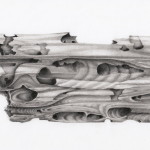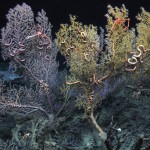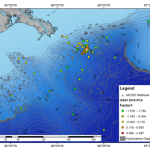The oil spill in the Gulf of Mexico is now over a month in duration and continues to worsen. Estimates of the total oil flowing from the damage were estimated initially at 5,000 barrels per day. Now the 26,000 estimate by FSU professor Ian MacDonald looks more plausible. Moreover, the greatest impact of the current spill may occur below, not above, the ocean surface. But the impacts of oil drilling to the deep sea began long before the first oil leaked from the damaged well.
Our scant prior knowledge of the deep sea in its natural state, combined with the technical challenges we face in understanding this remote habitat, mean we may never really know what change to expect or even how to detect it when it does. What we do know is that compared to shallow water, recovery rates in the deep-sea will be lower due to longer lifespans, slower growth/reproduction rates, and overall lower density and population sizes of organisms.
Below is a brief summary of how off-shore oil drilling and the oil spill will impact the deep.
Impact Types
Drill Cuttings are the actual material, water-based muds, removed from the borehole from the drilling operation. To this mud barium sulphate, potassium chloride, bentonite, caustic soda, citric acid, soda ash and polymers are added for stabilizing and weighting. Drilling muds and drill cuttings can be contaminated by a variety of heavy metals such as mercury, chromium, cadmium, lead and barium. The initial drill cuttings are deposited on the seabed. Subsequent material is discharged at the surface of the oil rig but will eventually deposit on the seafloor. This is likely to be the most significant and regular impact on the deep sea. In just 30 years in the North Sea 1.5 million tons of drill cuttings were left on the seafloor.
Produced water is a mixture of formation water and injected water. Oil and gas reservoirs have a natural water layer (formation water) that lies under the hydrocarbons. In addition, water is injected into the oil-bearing formation to maintain pressure for oil production. Produced water, along with the trace heavy metals, radionuclides, sulphates, treatment chemicals, produced solids and hydrocarbons, is discharged into the ocean.
Sand contaminated with oil is also produced during oil production and exploration and often deposited at sea.
Drains will carry any contaminated water from the oil platform into the water surrounding.
Seabed engineering in the form of positioning anchors and other submerged structures will both mechanically damage the seafloor and cause sediment plumes. Both impacts will smother organisms.
And of course massive and catastrophic oil spills that result in billions of barrels of spilled oil and half million gallons of the chemical dispersant Corexit 9500.
Results of Impacts
The impacts above will lead to the smothering of organisms, organic enrichment or reduction, exposure to toxins, etc. From oil drilling, these effects are local occurring in the near vicinity (<6km) of the operations with the greatest toxicity within 1km of the platform. Near oil platforms or in areas of high oil platform density, the total amount of seafloor organisms is known to be drastically reduced. The types of deep-sea species found near oil derricks also greatly differ from those found in natural and undisturbed habitats. Microbial and copepod communities exposed to crude oil or occurring with the vicinity of oil platforms also exhibit greatly reduced genetic diversity. Pollution throughout marine communities is associated with a loss of biodiversity both in terms of species richness and evenness. Although natural sedimentation occurs, the type, amount, and density of sedimentation occurring from drill cuttings are greatly different. As such, seafloor organisms will fair poorly.
In contrast to the above, the oil spill impacts will be regional or basin-wide. Toxins from the oil spill will likely integrate into the food chain and eventually arrive to the deep in the form of food. Flux of material from the ocean surface is also likely to transport oil and toxins to the deep ocean. Shading by the oil slick might also inhibit phytoplankton production and reduce carbon flux to the deep sea meaning less food for seafloor organisms. An overall reduction of biodiversity both in terms of species and genetic diversity is expected. Of course with the oil spill, it needs to be recognized that 48 million gallons of oil are leaked naturally in the Gulf of Mexico annually (the current spill is near 34 million gallons). On one hand this may have produced a more resilient fauna. On the other hand this might provide a tipping point that pushes many species and communities past which they can survive. It also should be considered that many organisms will be exposed to oil concentrations much higher than they would naturally.
- Rogers, A.D. (1999). The Biology of Lophelia pertusa (LINNAEUS 1758) and Other Deep-Water Reef-Forming Internal. Rev. Hydrobiol., 4, 315-406
- Smith, T., & Hughes, J.A. (2008). A review of indicators and identification of gaps: Deep-sea habitats Research & Consultancy Report , 45, 1-72
- Carney, R. (1997). Basing conservation policies for the deep-sea floor on current-diversity concepts: a consideration
of rarity Biodiversity and Conservation, 6, 1463-1485
- Hernández Arana, H., Warwick, R., Attrill, M., Rowden, A., & Gold-Bouchot, G. (2005). Assessing the impact of oil-related activities on benthic macroinfauna assemblages of the Campeche shelf, southern Gulf of Mexico Marine Ecology Progress Series, 289, 89-107 DOI: 10.3354/meps289089
- Johnston, E., & Roberts, D. (2009). Contaminants reduce the richness and evenness of marine communities: A review and meta-analysis Environmental Pollution, 157 (6), 1745-1752 DOI: 10.1016/j.envpol.2009.02.017
- Trannum, H., Nilsson, H., Schaanning, M., & Øxnevad, S. (2010). Effects of sedimentation from water-based drill cuttings and natural sediment on benthic macrofaunal community structure and ecosystem processes Journal of Experimental Marine Biology and Ecology, 383 (2), 111-121 DOI: 10.1016/j.jembe.2009.12.004
- Carr, R.S., Chapman, D.C., Presley, B.J., Biedenback, J.M., Robertson, L., Boothe, P., Kilada, R., Wade, T., & Montagna (1996). Sediment porewater toxicity assessment studies in the vicinity of offshore oil and gas production platforms in the Gulf of Mexico Canadian Journal Fisheries and Aquatic Science, 53, 2618-2628
Share the post "Anatomy of an ecological catastrophe: what to expect in the deep Gulf of Mexico"






Thanks for doing a measured, science-based take on this — something which is far too rare in these spill accounts so far.
One minor quibble, which might be more of a clarification or question: when you say “regional or basin-wide”, how big a region do you mean? If (when) the spill firmly becomes entrained within the Loop Current, we could be looking at a western North Atlantic problem, not just the Gulf of Mexico.
I worked in the Gulf Coast Oil fields for some 13 years or more since 1978.Inland barges,tinker toys and jack-ups.Wild cat drilling and workover.Oil and gas can be visually observed,naturally escaping or seeping to the surface into the environment.And I also remember drilling within site of a still burning disaster that happened a couple years before I had started in the oil feild,roustabouting for A&P.You have to remember that there is all kinds of lost overboard equipment on site as well as the rig and tiny pieces of the lost crew members.One of the main reasons I got out of the drilling industry is because of the Gods that sit behind the desk.All of the surroundings must be under constant visual observation,on and off the rig especially during casing runs and cement jobs.Open hole exposure allows no room for just routine.You must have available,a leadership that is hands on and observant,friendly and helpful,with time and money not an issue.I watched the water for changes in coloration,all senses must be employed even the feel of what is going on.You act on all changes as a failure in progress.I found that EGOcentric Moronic Leadership is Rampant in the drilling industry.I might be more inclined to jump to action on a Worms request about “something smells”,because he is hands on.A mile deep,water?Must be a trench I didnt hear about.I got a look at the picture on this site.I was on some inland barge wells closer in north of there.My experience is for every mile out the water drops a foot.I heard of a deep hole found that was expected to be rich in crude years back.I know that particular area of the river basin,closer in,has some pretty heavy currents and awesome tidal changes.I appreciate the opportunity to share opinion and experience.It’s a shame that adult human ego is so distructive.I need some money.Does anybody have any money?The oil companies do,don’t they?SHORT CUTS?Don’t forget that you cant order a”ship load of nut plug over-night and another well that ties in to pump it Through over-night”,you dopes!
The “you dopes” was directed to the individuals that are hiding and sniveling,instead of owning up to the truth.I have to stop driving trucks because I am not physically and emotionally capable anymore.Countries,companies and individuals must learn,”that is the promise we made for the gift of life,responsibility to preserve life,at the possible expense of my loss first”!
They will never take the blame. That will always be the case.
Giant cover up of true damage to Environment.Plug in to view live oil eruption not avaliable windows 7.BIGGEST LIE: BP we will clean every drop and pay for everything.Deep sea drilling permits still being issued.No mention of all life dying because of oil spill, oly talk about who pays.America, your Gulf of mexico is dying and you deserve it.Even if by devine intervention all the oil were to disappear,you would do it to yourselves again and again and again.Greed knows no bounds.We are a cancer on this Earth and Mother Nature will soon be rid of us.We are on a course of self DESTRUCTION.America is now getting ready for World War 3.SHAME ON YOU AMERICA, YOU REAP WHAT YOU SOW
I had a chance to look at leaks from the well and it doesnt look that bad.The B.O.P.s are still intact.Well cavitation and all the total collapse fears of the well just doesnt look like a real threat even if the riser was removed totally and letting it flow to get at the top of the stack.If it can be dressed up and refitted above or below that top preventer.I certainly dont no what pressure it might be holding back or what might be suspended in the preventers.I do see all the best available resources on the well site to regain control.My highest hopes go out to the safety and success of all envolved.A msg to all that enjoy the products that come from these wells,”we all have a hand in its use,so we all have a percentage of responsibility”.It isnt the end of life as we know it.Its just another thing that blew up in our faces.
Know not no.Think safety and success,safety and success,safety and success!
So basically, because we don’t know much about the Deep Sea, we dno’t know how much damage we’ve already caused to the deep sea beyond the BP Spill, and because of that, anything that we find in the deep sea might be permamently changed thanks to our actions?
That’s….kinda comforting to know *sarcasm*